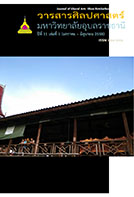Is Left or Right Better? A Branching Direction and the Processing of English Relative Clauses of Thai University Students
Main Article Content
บทคัดย่อ
Having taught English for Science and Technology (EST) for several years , the researcher have frequently observed that many of Thai students found the language of scientific thought extremely difficult to understand mainly because of complex sentence structures, such as those in Relative Clauses. As Biber (2006) acknowledges, relative clauses occur quite frequently in scientific and technical writing; and among non-prepositional posmodifiers , they are the most frequently used structure in genres ranging from conversation to fiction and academic texts (Biber et. al, 1999). In this article, attempts have been made to explore a branching direction of English relative clauses and its effect on language processing of Thai English as a Foreign Language (EFL) learners at Ubon Ratchathani University, Thailand. The study was conducted based largely on the hypothesis that the right branching structure would be more easily processed than the centerembedded, also called the left branching in this work. And thus, if similar information is structured in these two different directions, students should display a tendency toward less difficulties understanding the right branching, and hardly retain information in the matrix clause of the center-embedded. Results obtained hopefully illustrated one of the premises that state when teachers tried to understand learners' challenges and the characteristics of their teaching materials, they should be able to determine how to create the best possible materials and learning activities.
การสอนภาษาอังกฤษสำหรับวิทยาศาสตร์ และเทคโนโลยีในช่วงเวลา 2 - 3 ปีที่ผ่านมา ทำให้ผู้วิจัยเล็งเห็นว่านักศึกษาไทยจำนวนมากมีปัญหาด้านความเข้าใจต่อภาษาอังกฤษเชิงวิทยาศาสตร์ เนื่องจากโครงสร้างประโยคเชิงซ้อน ดังเช่น โครงสร้างอนุประโยค ไบเบอร์ (2006) กล่าวว่า โครงสร้างภาษาแบบอนุประโยคจะพบมากในงานเขียนเชิงวิทยาศาสตร์และเทคนิค และในกลุ่มส่วนขยายคำที่ไม่ใช่บุพบท โครงสร้างอนุประโยคนับเป็นโครงสร้างที่ใช้บ่อยที่สุดในภาษาหลายรูปแบบ เช่น บทสนทนา บันเทิงคดี และงานวิชาการ (ไบเบอร์และอื่นๆ, 1999) บทความวิจัยฉบับนี้มีความพยายามนำเสนอการศึกษาทิศทางการกระจายข้อมูลของโครงสร้างภาษาแบบอนุประโยค และผลกระทบของโครงสร้างดังกล่าวต่อความเ ข้าใจภ าษา ของนักศึกษาภาษาอังกฤษในฐานะภาษาต่างประเทศ มหาวิทยาลัยอุบลราชธานี ประเทศไทย งานวิจัยเรื่องนี้ยังจัดทำขึ้นบนข้อสันนิษฐานหลักที่ว่า โครงสร้างการกระจายข้อมูลในทิศทางขวาง่ายต่อความเข้าใจมากกว่าโครงสร้างการกระจายข้อมูลในทิศทางกลางซึ่งถูกเรียกว่าทิศทางซ้ายในงานวิจัยฉบับนี้ด้วย ดังนั้นหากมีการนำข้อมูลที่คล้ายคลึงกันบรรจุในโครงสร้างอนุประโยคสองทิศทางที่แตกต่างข้างต้น นักศึกษาจะมีโอกาสไม่เข้าใจโครงสร้างแบบแรกน้อยกว่า และไม่สามารถจดจำข้อมูลที่เกิดขึ้นในประโยคหลักเมื่ออ่านโครงสร้างแบบที่สองมากกว่า ทั้งนี้ผู้วิจัยหวังว่าผลการวิจัยจะนำเสนอข้อสมมุติฐานที่ว่าหากผู้สอนภาษามีความเข้าใจในปัญหาของผู้เรียนและลักษณะของสื่อการเรียนการสอน ผู้สอนจะสามารถสร้างสื่อการเรียนการสอนหรือกิจกรรมการเรียนรู้ที่เหมาะสมกับผู้เรียนได้อย่างมีประสิทธิภาพ
Downloads
Download data is not yet available.
Article Details
รูปแบบการอ้างอิง
Kimura, L. N. (2015). Is Left or Right Better? A Branching Direction and the Processing of English Relative Clauses of Thai University Students. วารสารศิลปศาสตร์ มหาวิทยาลัยอุบลราชธานี, 11(1), 141–185. สืบค้น จาก https://so03.tci-thaijo.org/index.php/jla_ubu/article/view/89915
ประเภทบทความ
Articles


